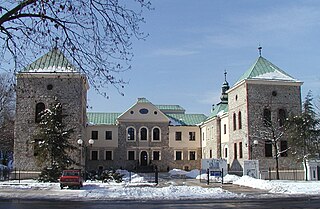
Sielecki Castle is a castle in the city of Sosnowiec in southern Poland, located in the Sielc distric. The castle is located on the left bank of the Czarna Przemsza River. It was built in the 17th century and it is the oldest building in the city.
The Dunajec river castles is a chain of thirteen medieval castles, built in southern Lesser Poland, along the Dunajec river. The castles protected the border between the Kingdom of Poland and the Kingdom of Hungary, as well as a very important international trade route, which went along the Dunajec and the Poprad all the way down to the Danube river. Most of the castles are in ruins now, and some have disappeared. Their history dates back to the period known as the Fragmentation of Poland in the early 12th century, when, according to his will, known as the Testament of Bolesław III Wrymouth, the country was divided into several provinces. The Dunajec river castles were located on the territory of two castellanies, Wojnicz and Nowy Sącz, in the extreme south of the Seniorate Province.

Toruń Castle or Thorn Castle is a 13th- or 14th-century castle of the Teutonic Order located in Toruń (Thorn), Poland. The Castle is part of the Medieval Town of Toruń, one of the World Heritage Sites in Poland.

Bobrowniki Castle was built by the Teutonic Knights in the late fourteenth, early fifteenth centuries. Following the Peace of Thorn (1411), it was taken over by the Polish, later to become a residence of the local mayor. Since the eighteenth century the castle lies in ruins.

The Castle of the Masovian Dukes is a Gothic castle located in Czersk, Masovian Voivodeship in Poland.
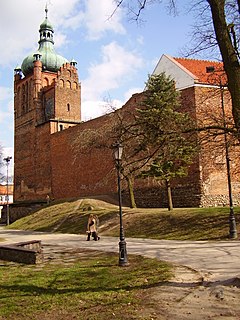
The Castle of the Masovian Dukes in Płock is a Gothic castle built under the reign of Casimir III the Great, becoming a stronghold of the Dukes of Masovia until the fifteenth century. The castle is located in the Princely Capital City of Płock, Masovian Voivodeship; in Poland.

Kwidzyn Castle is a large brick gothic castle in the town of Kwidzyn, Poland. It is an example of Teutonic Knights' castles architecture.

Grodno Castle is a castle located in the southern parts of the Wałbrzych Mountains, on the Choina Mountain, standing to the left of the river Bystrzyca. The valley of this river, formerly known as the Silesian Valley, creates a natural boundary between the Owl Mountains and to the west of it the Wałbrzych Mountains. The castle is located in Zagórze Śląskie, Lower Silesian Voivodeship in Poland.

Radzyń Chełmiński Castle - a castle built in a square formation; the seat of the Teutonic Knights' Commandry, located close to the Castle Lake to the north of the town of Radzyń Chełmiński. Currently partially in a ruin.

Rawa Mazowiecka Castle is a Gothic architectural style square formation castle located in Rawa Mazowiecka, in the lowlands of the river Rawka and the river Rylka. Currently it is a renovated ruin.

Sobieski's Castle in Oława is a Renaissance-Baroque style castle located in the site of a former Gothic castle. The original castle had been built by Duke Ludwik I built in the second half of the fourteenth century. It was the third castle structure in Oława, the first being the seat of the castellans, located in the south-east of the town. It remained an integral part of the town's defenses until the wars with the Hussites.

Teutonic Castle in Świecie - a partial ruin located in Świecie. The partial ruin is kept in full-shape from the bank of the river Vistula and Wda - together with a circular tower topped with merlons. The castle is part of a complex built by the Teutonic Knights in the Gothic architectural style. The castle was built on the site of a Pomeranian dukes' gord - located by the site of the castle. Formerly the castle had four corner towers, one of which survived. The castle is surrounded by a defensive wall and a moat. In 1410 the castle was looted by Polish forces obliterated the castle. The castle was owned by the Kingdom of Poland after the Second Peace of Thorn in 1466. In the sixteenth century, Castellan Konopacki reconstructed the castle into the Renaissance architectural style. The castle was devastated after the Deluge and since then was not rebuilt. The castle was furthermore devastated after Prussian forces used the castle as training grounds. Currently the castle houses a museum, with the tower and castle renovated.

The Olsztyn Castle, officially known as the Warmian Bishops' Castle, is a Brick Gothic castle located in the heart of Olsztyn, in northern Poland. Built in the 14th century, it served as the administrative seat for the Bishops of Warmia alongside Lidzbark Castle. The most well-known administrator caretaker was Nicolaus Copernicus, who resided here between 1516 and 1521. The largest expository room is the refectory with a diamond vault built around 1520. Currently, the castle houses the Museum of the Warmian-Masurian Voivodeship.

Międyrzecz Castle - a castle surrounded by a dike, raised in around 1350 by Casimir III the Great in the place of a former gord from the second half of the ninth century, located on a small hill in between two floodplains of the Obra and Paklica Rivers.

Oświęcim Castle is a castle raised in the Medieval Ages on the top of a hill, on the right bank of the River Soła in Oświęcim.

Braniewo Castle - a castle built in the thirteenth century in Braniewo. The castle's remains are located in south-eastern side of the Old Town by St. Catherine's Basilica.

Bytów Castle is a gothic Teutonic castle and a former stronghold for Pomeranian dukes.
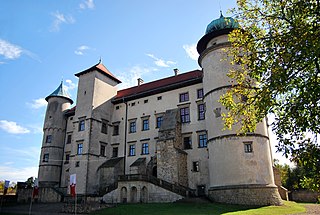
Nowy Wiśnicz Castle - a castle located on a forested hill by the River Leksandrówka in the village of Stary Wiśnicz, Lesser Poland Voivodeship; in Poland. The castle was raised by Jan Kmita in the second half of the fourteenth century. The castle was built in the Baroque architectural style with Renaissance elements. The castle was built on the plan of the quadrilateral with the inner courtyard. The castle has four towers, with one in each corner. The castle is surrounded by bastion fortifications and the main gate from the early 17th century.
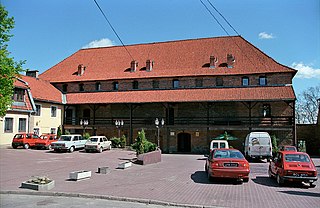
Nowe Castle - a castle located on the bank of the River Vistula by the Castle Square.
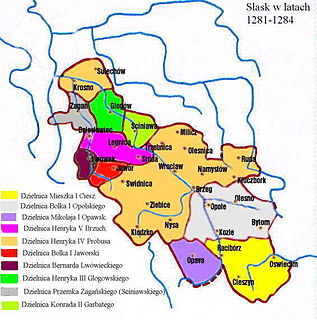
The Duchy of Löwenberg or Duchy of Lwowek was one of the Duchies of Silesia established in 1281 as a division of the Duchy of Jawor. The duchy of Lwowek was ruled by the Silesian Piast, Bernard the Lightsome, with its capital at Lwowek Slaski in Lower Silesia, which gained town rights in 1217.




















